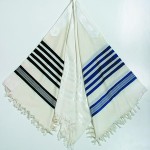When I was growing up there was just one type of tallit in shul, white with black stripes, but later I began to see silver or gold pinstripes appear between the black bands of the traditional wool design, and the occasional blue-striped tallit.
Today’s prospective tallit buyer has a broad spectrum of tallitot to choose from. In many Orthodox congregations the black-on-white tallit still dominates the scene, tallits with some blue or silver are now very common, and very modern designs are also widely available.
Fabric
When you set out to buy a tallit, the first order of business is to select the type of fabric you prefer. The least expensive fabric is synthetic, often referred to as the Acrylan Tallit. This type of tallit typically sells for $35-$75, depending on the size you choose.
Wool is the most common tallit fabric, and is considered preferable according to halacha. Typical prices are $60-$150 (again, depending on size of course) for a basic wool prayer shawl. The more expensive wool tallits are made of a denser weave and may include special features, such as wool corners and stain-resistant fabric.
In handwoven tallits you will often come across cotton as well, or silk, which enables greater detail and sheen.
Color

Though the age-old wool tallit is invariably white with black stripes, some Sephardic Jews have a custom of wearing a white-on-white tallit, which has a very elegant and distinguished look. If you stay in the realm of the traditional wool tallit, common striping colors include black and silver, blue and silver, varying shades of blue or rainbow striping, as in the well-known Bnei Ohr design. Many people opt to buy a tallit with blue stripes.
Tallit Buying Tip: Don’t overlook the tzitzit
Many tallits are sold with machine-spun tzitzit already tied on. They are invariably thin and tied according to the Ashkenazi custom, which is the predominant tying custom. The difference between machine-spun tzitzit and hand-spun tzitzit is primarily a halachic distinction (see “Kosher Tzitzit Strings: A Matter of Intent“). If you prefer thick tzitzit, you will have to upgrade to hand-spun. Also, if you would like the tzitzit tied according to a different custom – Sephardic, Yemenite, Chabad – you will have to upgrade to hand-spun. Note that most tallit sellers lack the know-how to accommodate all tzitzit tying requests.
Today, techelet tzitzit are becoming quite common. For information on the two different types of techelet available, see “Ptil Tekhelet and Radzin Techelet.”
Buy tallit on Amazon or eBay: You get what you pay for
If you decide to buy a tallit on Amazon or eBay, you might find a good bargain, but it will limit your options. I get the impression those who buy a tallit on Amazon or eBay are mostly Christians who practice so-called Messianic Judaism and are in the market for an inexpensive synthetic tallit. Synthetic tallit prices are tempting, but really it’s not such a bargain when you consider that wholesale prices for synthetic tallits are 30%-50% less than for a wool tallit. You get what you pay for: a wool tallit lasts longer, looks better, and is preferable according to halacha.
As a tallit seller I may be somewhat biased, but I cannot fathom why you wouldn’t want to shell out another $20 to buy a decent tallit. If you’re only wearing the tallit once a week, a wool tallit can easily last for 10 or 20 years.
If you find a very low-priced tallit posted on Amazon, before you reach for your credit card be sure to compare sizes. A Size 24 tallit, for example, uses half the amount of fabric as a Size 50 tallit, which makes the difference in price considerable. Also, keep in mind that you won’t have any tzitzit options to choose from.
Should I buy a tallit from Israel?
I often get inquiries from prospective customers who are about to visit Israel and would like to drop by my shop to buy a tallit. While it’s always easier to see and feel the tallit before you buy, if they think buying a tallit during their visit to Israel will save them money, they’re wrong. The reason is the 18% value-added tax. That means if they buy tallit for $100, $18 goes straight to the government. But when a customer outside of Israel opts to buy a tallit from from Israel, by listing it on the export registry it will be exempt me from VAT altogether.
The leading tallit makers are based in Israel, and shipping is not a significant expense. To promote “buying blue and white” the Israeli government keeps international shipping rates low. Of course many people prefer to buy a tallit from Israel not so much to save money, but to support Israel with their tallit purchase. And since many of the leading tallit makers are located in Israel, it makes sense to buy a tallit from the source.

